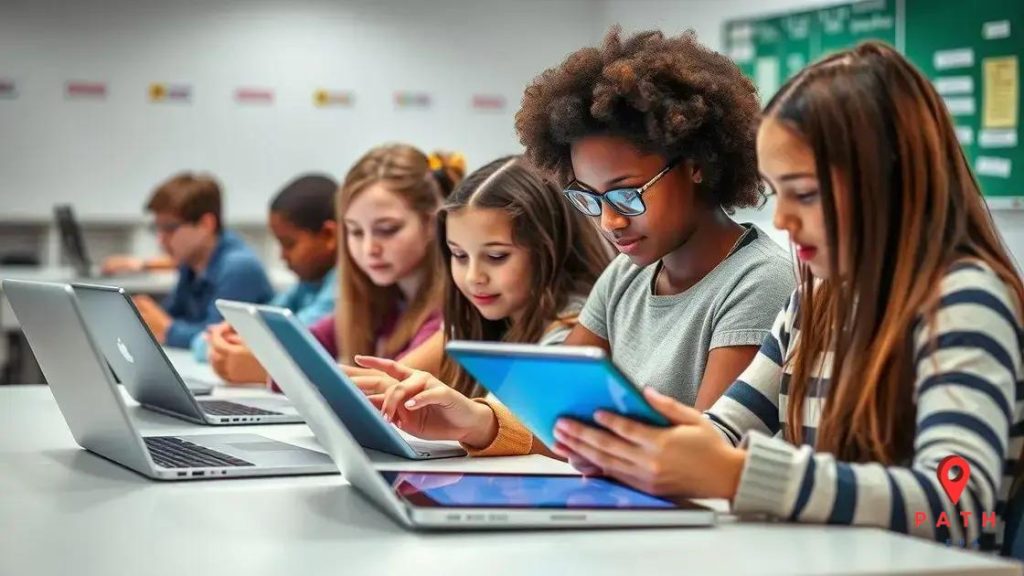EdTech innovations: transforming education for the better

Anúncios
EdTech innovations leverage technology, including AI and gamification, to enhance personalized learning experiences, improve student engagement, and streamline educational processes across various settings.
EdTech innovations are changing the way we view and engage with education. Have you ever wondered how these advancements can enhance learning and accessibility? In this article, we’ll dive into the transformative power of technology in education.
Anúncios
The impact of technology on education
The integration of technology in education has transformed the traditional classroom setup. Students today are using devices like tablets and computers, allowing for a more interactive learning experience.
With online resources easily accessible, learners can explore subjects in depth and at their own pace. Platforms such as Khan Academy offer a range of free courses that cater to different educational needs.
Anúncios
Benefits of Technology in Education
There are several key benefits linked to using technology in educational settings:
- Enhanced engagement: Digital tools often make learning more exciting.
- Personalized learning: Technology allows students to learn according to their strengths and weaknesses.
- Global collaboration: Students can connect with peers worldwide for broader perspectives on subjects.
As technology continues to evolve, it’s essential to stay updated on the latest educational tools. For further insights, visit Edutopia, a trusted resource for educators.
Innovative tools for remote learning
Remote learning has become increasingly popular, making innovative tools essential for effective education. With technology at our fingertips, learning can happen anywhere and anytime.
Several tools have emerged that enhance the remote learning experience, providing interactive and engaging environments for students.
Popular Innovative Tools
Some of the most effective tools include:
- Video conferencing platforms: Tools like Zoom and Microsoft Teams allow teachers to conduct live classes and interact with students.
- Learning management systems: Systems such as Canvas and Moodle organize course content, assignments, and feedback.
- Collaboration tools: Platforms like Google Docs and Padlet enable students to work together on projects in real-time.
These tools not only facilitate communication but also foster a sense of community among remote learners. For more information about remote learning tools, check out EDUCAUSE, a leading source for technology in higher education.
Gamification in learning: engaging students

Gamification has gained popularity in education as a way to enhance student engagement. By integrating game mechanics into learning activities, educators can create a more motivating environment.
Using gamification, students often feel more excited about their lessons. This approach transforms tasks into fun challenges.
Benefits of Gamification in Learning
There are several advantages to incorporating gamification:
- Increased motivation: Game elements encourage students to participate more actively.
- Improved retention: Learning through play helps students remember information better.
- Collaboration: Many gamified activities promote teamwork among students.
Teachers can use platforms like Kahoot! or Quizizz to make quizzes more interactive and enjoyable. For more details, visit Edutopia, which offers insights on effective educational strategies.
Artificial intelligence in educational settings
Artificial intelligence (AI) is making a significant impact in educational settings, enhancing how students learn and teachers instruct. By integrating AI technology, schools can provide personalized education tailored to individual needs.
AI tools analyze student performance and adapt lessons accordingly, ensuring that every learner gets the support they require.
Applications of AI in Education
AI is used in various ways to improve teaching and learning:
- Personalized learning: AI can create customized learning paths for each student, adjusting challenges based on their progress.
- Automated grading: Educators can save time by using AI to grade assignments and provide instant feedback.
- Virtual tutors: AI-powered chatbots can assist students outside of class, answering questions and guiding them through complex subjects.
As AI continues to evolve, educational institutions must stay informed about the best practices. For further insights, explore resources at EDUCAUSE, which offers up-to-date information on technology in education.
Future trends in EdTech to watch for
The world of education technology, or EdTech, is constantly evolving. Staying informed about future trends can help schools and educators effectively adapt to new tools and methods. These trends often aim to improve student engagement and enhance the learning experience.
As technology advances, certain patterns emerge that can shape the future of education.
Key Trends in EdTech
Here are several important trends to watch for:
- Adaptive learning: This approach tailors educational content to meet the individual needs of each student, ensuring personalized learning paths.
- Augmented and virtual reality: AR and VR are being used to create immersive learning experiences, allowing students to explore subjects in a hands-on way.
- Artificial intelligence: AI will continue to play a role in automating administrative tasks and supporting personalized learning through smart tutoring systems.
For more insights into the future of EdTech, visit Edutopia, which provides valuable resources and articles about innovations in education.
FAQ – Frequently Asked Questions about EdTech Innovations
What is EdTech and why is it important?
EdTech, or education technology, refers to the use of technology in education to enhance learning experiences, improve student engagement, and streamline administrative tasks.
How can AI improve the learning experience?
AI can analyze student performance and provide personalized learning paths, helping educators tailor instruction to meet individual student needs more effectively.
What role does gamification play in education?
Gamification uses game elements to make learning fun and engaging, which can motivate students and improve their retention of information.
What are some future trends in EdTech?
Key future trends include adaptive learning, augmented and virtual reality, and the continued use of AI to support personalized education.